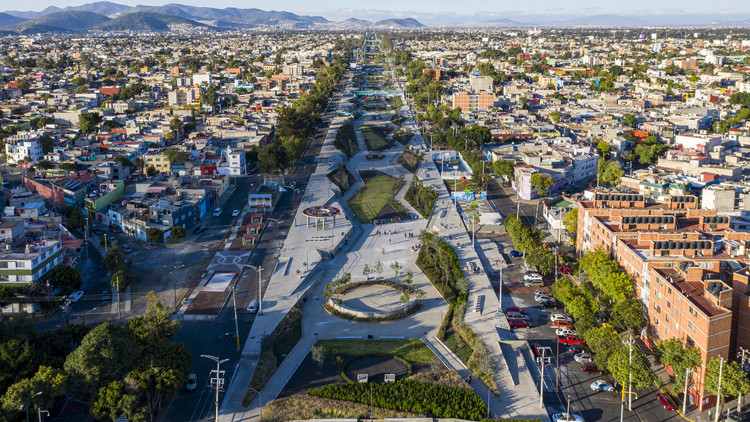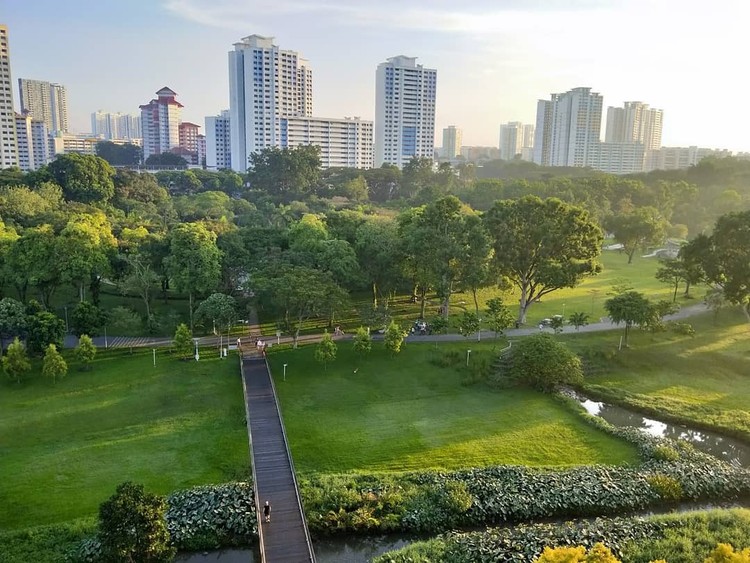
Extreme natural events are becoming increasingly frequent all over the world. Numerous studies indicate that floods, storms, and sea-level rise could affect more than 800 million people worldwide, ultimately costing cities $1 trillion per year by the middle of the century. This suggests that urban survival depends on addressing urban vulnerability as a matter of urgency to protect the city and the population.
Given the background, many urban design projects started to introduce nature-based solutions (NBS) to provide sustainable management of ecosystems to tackle different environmental challenges. These solutions can reconnect the population with nature, mitigate air pollution, improve thermal comfort in the cities, reduce the effect of urban heat islands, and manage stormwater runoff, among many other benefits to the environment, and to the physical and mental health of urban dwellers. Moreover, NBS can also contribute towards creative designs that can cost much less than traditional solutions.
Below, we have selected six urban projects that embody nature-based solutions addressing different challenges of the contemporary world.
Bishan-Ang Mo Kio Park, Singapore
Nature-based solutions require stepping outside the comfort zone, trying creative non-obvious alternatives, and close collaboration between many different work fronts. This process is challenging, but not impossible, as we can see in the Bishan-Ang Mo Kio Park in Singapore.

A few decades ago, the city decided to channelize the Kallang River creating a linear fenced canal that was a clear dividing line between the park and community. In dire need of an upgrade, the concrete canal could be redesigned but Singapore's national water agency decided to naturalize the river by restoring the original riverbed and floodplain. The 2.7 km straight concrete drainage channel was torn down and transformed into a meandering 3.2 km long natural river.
The result is a blue-green infrastructure project that provides flood prevention and improved water quality, increasing the benefits of the canal to the community. Combining natural materials, civil engineering techniques, and plants that can filter and absorb water was essential to stabilize the riverbanks and prevent erosion.
The National University of Singapore carried out a cost-benefit analysis that reported that rebuilding the concrete canal would cost about US$94 million (133 million SGD, Singapore dollars). Naturalization, on the other hand, cost just under US$50 million (70 million SGD) and further contributed to expanding and reconnecting the park areas to the city.

In other words, besides all the environmental benefits from the improved flood management and water quality, and the positive impact on people's physical and mental well-being by bringing them closer to nature, this NBS has also generated significant financial savings, achieving great results for a fraction of the cost of traditional solutions.
Green Corridors, Colombia
Over the past few years, city authorities of the Colombian city of Medellín have transformed the verges of 18 roads and 12 waterways into a green paradise. The Green Corridors project consists of planting trees along thoroughfares to mitigate the effects of urban heat islands caused mainly by the overuse of concrete and asphalt.

For example, the Avenida Oriental, one of the busiest roads in the city, was remodeled and had over 2 kilometers of paving on the pedestrian island and sidewalks replaced by gardens. More than 600 trees, palms, and thousands of smaller plants of carefully selected species have been planted, allowing the native wildlife to return to the area. Today we can see many different birds, such as parakeets and parrots, also butterflies, and even squirrels traveling through the city.
The initiative focused on areas that most lacked green spaces and managed to reduce air temperature by more than 2°C. The Green Corridor project won the 2019 Ashden Award for Cooling by Nature Award, supported by the Kigali Cooling Efficiency Program.
Rain Garden, Brazil
Similar to the previous project, this one also addresses the issue of impermeability of the urban landscape. Rain gardens are specifically designed to reduce the flow rate, total quantity, and pollutant load of stormwater runoff. This practice is used to treat urban runoff using plants, stones, and other natural or engineered elements. Suspended solids are filtered out of the water as it moves down through the soil and interspersed plant roots. These gardens can be executed near sidewalks, roads, flowerbeds, or even inside lots.

In 2019, the first rain garden in the city of Rio de Janeiro was installed at the Fundição Progresso Cultural Center, kicking off with an action called Dia da QuebrAção (Wrecking Day) in which the concrete sidewalk in front of the building began to be removed, to be replaced with 200 square meters of green space. Cecilia Herzog and Daniel Gabrielli, who were in charge of the project, say that bringing nature back to urban life and learning from it, cooperating with all species, and using nature's techniques for the benefit of the city, is a major paradigm for the 21st century.
Lineal Gran Canal Park, Mexico
Like the green corridors in Medellín, this linear park in Mexico City is based on environmental regeneration, through reforestation of the urban fabric and restoration of soil permeability, which has resulted in an increase of 16% in the relative humidity of the air and a reduction of up to 5% in temperature, mitigating the effect of heat islands.

The park provides many environmental benefits, but furthermore, it symbolizes the reclaiming of a neglected space. It was built over the capital's historic Grand Canal structure, integrating more than 70,000 square meters of land that used to be divided by this harsh line in the urban fabric. The intervention focused on recovering the native vegetation and riparian forest of the old canal, transforming the area into a 100% permeable public space.

Stormwater Wetland Park, China
This park is located right in the middle of the city, in an area that is listed as a protected regional wetland. The site is surrounded by roads and dense development on four sides, so water sources were being cut, and the wetland was under threat. The architects' strategy was to transform the dying wetland into a ‘green sponge,’ an urban stormwater park which not only rescues the disappearing wetland but also provides multiple services for the new urban community.

The project follows four guidelines. First, the central part of the existing wetland was left untouched, allowing it to evolve and transform naturally. The second strategy was to create a ring of ponds and mounds surrounding the former wetland using simple cut-and-fill techniques, which creates a buffer zone for the core of the wetland and a welcoming landscape filter between nature and the city. Third, a network of paths and urban furniture on ground level, allowing visitors to experience walking through a forest. And finally, the fourth strategy was to create elevated walkways that connect the scattered mounds with platforms and viewing towers that frame different perspectives of the natural landscape.

This nature-based solution has transformed the wetland into a multifunctional stormwater park that collects, filters, stores rainwater, and infiltrates the aquifer while being productive and pro-life, providing new recreational and aesthetic experiences for the city. The park has greatly contributed to the survival of the natural environment while also acting as an effective drainage green infrastructure for the area, which was frequently affected by floods from June to August.
Urban Farming in several countries
Urban farming has been a growing practice in many cities around the world through independent or governmental initiatives. The city of San Francisco, for example, is giving tax breaks for allowing communal urban farming on empty lots. In Tokyo, five rooftop community vegetable gardens located on top of train stations were inaugurated in 2014. In Barcelona, independent initiatives run by retired people created large vegetable gardens in abandoned peripheral areas.

Meanwhile, the 'Quintais Susentáveis' (sustainable backyards) initiative in the state of Roraima, northern Brazil, stands out because it combines sustainable production based on agroecology, food & nutrition security with income-generating activities for vulnerable people, promoting social and labor inclusion. The program educates families in sustainable production and also encourages them to sell their products in local markets. This allows many possibilities, including the production of seedlings and organic compost.


The project also relies heavily on collaborative activities. The plant species are selected with community participation through a survey carried out to understand the family's eating habits so that everyone feels included in the process.




















